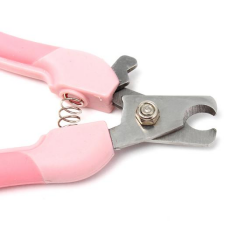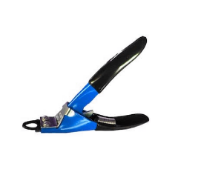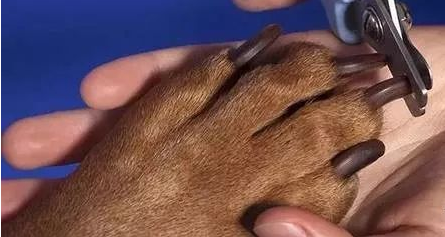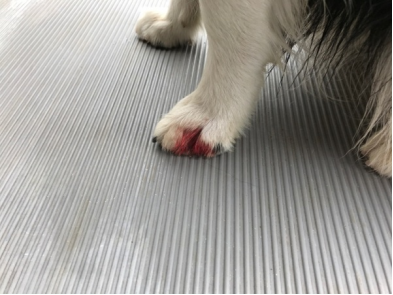Hear a click on the kitchen floor? This may indicate that your dog desperately needs to cut his nails!
Nail care is important, but it is often overlooked by owners who don’t know how to do it, are afraid to trim their nails, or cannot get their dog to fully accept the plan.
It is important to keep your dog’s paws nice and short. If they grow too long, your dog is at risk of being caught by them. This may cause the paw to tear or worse. Even if this does not happen, your dog will be uncomfortable walking around with too long paws.


Trimming Your Dog’s Nails at Home
Some pet owners will choose to take their dog to the vet or beauty salon for Trimming nail. This is something you can easily learn to do on your own, and there are many benefits to trimming your dog’s nails at home.
More economical. Trimming your dog’s nails at home is more cost-effective than taking your dog to the vet or beauty salon. Over time, the cost of professional nail art has gradually increased!
Improved health. You can trim your nails more often. Dogs with shorter nails will be more comfortable and will not be caught by any objects. When the dog walks, the longer nails will bend, causing pain and discomfort.
Safer for your family. When you or your child is playing with the dog, shorter nails can prevent scratches.
Decreased stress. If your dog is too anxious or resists nail trimming, you can schedule nail trimming according to the actual situation.
So what kind of tools do you need to choose to trim your dog’s toenails at home?
Dog Nail Clippers: Pros and Cons
There are two different styles of nail clippers: guillotine and scissors.
A common one is pet scissors. As the name suggests, it works in the same way as traditional scissors. Many of them look like a pair of pliers, but one of the blades is curved, allowing you to put each nail in the curve before trimming. Their sturdiness makes them very suitable for holding large dog breeds with large and thick nails.


The guillotine is the second tool. It works by inserting a dog nail into a hole and then using a handle to lower the cutting tip blade, just like a guillotine. They have handles like ordinary nail clippers. When you close the handle, the dog’s nails are trimmed neatly. It is ideal for small and medium-sized dogs because the nail must be inserted in the hole to be clamped.


Pros
quickly. Because scissors need to be cut once or twice, instead of gradually filing downwards, they can cut off pet nails faster. This is useful if you have an irritable or nervous dog.
Low noise and no vibration. Although the scissors will still make a snipping sound when cutting nails, your dog will not be affected by constant noise or vibration. You may need to spend less time making them insensitive to the cutting process, especially if you have a dog that is sensitive to sound.
cheaper. It is still important to invest in a set of high-quality scissors, but they are cheaper than grinders.
No battery or power cord is required. Clippers are more convenient and more portable because they do not rely on batteries or power cords. You can also save the cost of replacing the battery.
It is easier to remove broken nails. If your dog hooks their nails and leaves a clumsy nail, it is much easier to remove it with scissors. If their nails are severely injured, you should take them to the vet for evaluation.


Cons
May be difficult to use on thick nails. If you have a large variety with thick nails, even with a scissor trimmer, getting the scissors to cut can be a challenge.
It is more likely to cut the blood line of the dog. If you make a mistake or your dog moves, it is easy to cut off the dog’s blood line. This is especially true for dogs with darker nails, because it is difficult to see the beginning of blood vessels. Cutting the blood line is not a medical disaster, but it may bleed a lot and cause pain to your dog. In addition to the immediate pain, this experience can also cause your dog’s aversion to cutting nails in the future.
May cause jagged or cracked nails. Cutting does not round the edges like a grinder. This leaves jagged edges, which are more likely to be pinched or cause discomfort. Separating the nails is also easier, especially if you cut the wrong angle.
Can cause painful pressure. The nail clippers need to be pressed down with strong pressure. This may cause uncomfortable pressure or squeezing. For dogs with thick nails or cutting at the wrong angle, trimming is usually more painful.


Dog Nail Grinders: Pros and Cons
Nail grinders work differently from clippers, because they rotate the grinding surface that needs to be placed on the surface of the nail. The surface gradually wears away nails in the same way as sandpaper works on wood. The dog’s nails are not trimmed quickly, but filed gradually down at high speed. Gradually sand until you reach the desired length.
The nail grinder uses batteries or electricity to keep the tip moving, and you can charge the tool before use.


Pros
Gradually polish and control. The grinder gradually files the nail instead of cutting it. You can better control the number of nails you polish, thereby reducing the chance of hitting fast (sensitive nail blood vessels).
Smoother surface. Nail clippers sometimes leave jagged or sharp edges. The grinding machine produces smooth edges.
Useful for dogs who are afraid of scissors. If your dog has a bad experience with scissors, or they don’t like the pressure on their nails, then they may be more willing to accept a grinder. However, you still need to make your dog insensitive to noise and vibration.
Easy to use on thick nails. Sometimes scissors can cause nails to split. This is more common for thick nails or when the scissors are not strong enough. You can use a grinder to avoid these potential problems.


Cons
Some dogs don’t like noise or vibration. The grinder is noisier than scissors. They can also cause slight vibrations when pressed on the nails. This can make some dogs uncomfortable-especially when they are nervous or anxious. However, by introducing the grinder through the desensitization process, you can usually get them to accept it.
Nail dust. Grinding will generate quite a bit of dust—especially if you have a large dog with thick nails. Some grinders have a protective case to collect dust.
Still need to avoid rubbing to the blood line. Using a grinder is not foolproof. It is still possible to file too far and rub to the blood line. Don’t be overconfident, novices please use a slower speed.
Generate heat. The longer you use the grinder, the more heat is generated. If the nails are very long or thick, you may need to trim them in a short period of time to make sure you don’t burn the dog’s paws. Use the grinder at high speed settings to make it heat up faster.
Long hair may be entangled in the strap. Long claw hairs may become entangled on the rotating belt of the grinder. You need to remove it, which can cause discomfort and stress. Keep the claw hair trimmed or pulled back—especially for long-haired breeds.
Dog Nail Grinder vs Clipper: Which One Should You Choose for Your Dog?
In my opinion, for most non-professionals, dog nail polisher is a better grooming tool. If you are nervous about cutting your nails, the grinder is especially useful because you don’t need to be so precise and you are less likely to cut the dog’s blood line.
If you have a dog who is sensitive or anxious to sound, then nail clippers may be a good choice.
However, no matter which tool you use, it is always a good idea to take the time to establish a positive connection between your dog and the tool.
By weighing the pros and cons listed above, I hope I have helped you decide between dog nail clippers or grinder.

